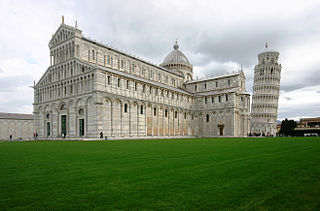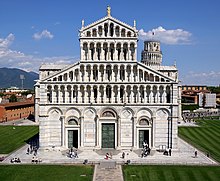
The Baroque is a Western style of architecture, music, dance, painting, sculpture, poetry, and other arts that flourished from the early 17th century until the 1750s. It followed Renaissance art and Mannerism and preceded the Rococo and Neoclassical styles. It was encouraged by the Catholic Church as a means to counter the simplicity and austerity of Protestant architecture, art, and music, though Lutheran Baroque art developed in parts of Europe as well.

Pisa is a city and comune (municipality) in Tuscany, central Italy, straddling the Arno just before it empties into the Ligurian Sea. It is the capital city of the Province of Pisa. Although Pisa is known worldwide for its leaning tower, the city contains more than twenty other historic churches, several medieval palaces, and bridges across the Arno. Much of the city's architecture was financed from its history as one of the Italian maritime republics.

Pope Nicholas IV was head of the Catholic Church and ruler of the Papal States from 22 February 1288 to his death, on 4 April 1292. He was the first Franciscan to be elected pope.

The Leaning Tower of Pisa, or simply the Tower of Pisa, is the campanile, or freestanding bell tower, of Pisa Cathedral. It is known for its nearly four-degree lean, the result of an unstable foundation. The tower is one of three structures in Pisa's Cathedral Square, which includes the cathedral and Pisa Baptistry.

Cathedrals, collegiate churches, and monastic churches like those of abbeys and priories, often have certain complex structural forms that are found less often in parish churches. They also tend to display a higher level of contemporary architectural style and the work of accomplished craftsmen, and occupy a status both ecclesiastical and social that an ordinary parish church rarely has. Such churches are generally among the finest buildings locally and a source of regional pride. Many are among the world's most renowned works of architecture. These include St Peter's Basilica, Notre-Dame de Paris, Cologne Cathedral, Salisbury Cathedral, Antwerp Cathedral, Prague Cathedral, Lincoln Cathedral, the Basilica of Saint-Denis, Santa Maria Maggiore, the Basilica of San Vitale, St Mark's Basilica, Westminster Abbey, Saint Basil's Cathedral, Antoni Gaudí's incomplete Sagrada Família and the ancient cathedral of Hagia Sophia in Istanbul, now a mosque.

The Palatine Chapel in Aachen is an early medieval chapel and remaining component of Charlemagne's Palace of Aachen in what is now Germany. Although the palace itself no longer exists, the chapel was preserved and now forms the central part of Aachen Cathedral. It is Aachen's major landmark and a central monument of the Carolingian Renaissance. The chapel held the remains of Charlemagne. Later it was appropriated by the Ottonians and coronations were held there from 936 to 1531.

The Piazza dei Miracoli, formally known as Piazza del Duomo, is a walled 8.87-hectare (21.9-acre) compound in central Pisa, Tuscany, Italy, recognized as an important center of European medieval art and one of the finest architectural complexes in the world. It was all owned by the Catholic Church and is dominated by four great religious edifices: Pisa Cathedral, the Pisa Baptistery, the Leaning Tower of Pisa, and the Camposanto Monumentale. Partly paved and partly grassed, the Piazza dei Miracoli is also the site of the Ospedale Nuovo di Santo Spirito, which now houses the Sinopias Museum and the Cathedral Museum.
The year 1960 in architecture involved some significant architectural events and new buildings.

William Wilkinson Wardell (1823–1899) was a civil engineer and architect, notable not only for his work in Australia, the country to which he emigrated in 1858, but for a successful career as a surveyor and ecclesiastical architect in England and Scotland before his departure.

Iglesias is a comune and city in the province of South Sardinia, Italy. It was co-capital of the province of Carbonia-Iglesias with Carbonia, and the province's second-largest community.

The Basilica of San Frediano is a Romanesque church in Lucca, Italy, situated on the Piazza San Frediano.

San Miniato is a town and comune in the province of Pisa, in the region of Tuscany, Italy.

Pisa Cathedral, officially the Primatial Metropolitan Cathedral of the Assumption of Mary, is a medieval Catholic cathedral dedicated to the Assumption of the Virgin Mary, in the Piazza dei Miracoli in Pisa, Italy, the oldest of the three structures in the plaza followed by the Pisa Baptistry and the Campanile known as the Leaning Tower of Pisa. The cathedral is a notable example of Romanesque architecture, in particular the style known as Pisan Romanesque. Consecrated in 1118, it is the seat of the Archbishop of Pisa. Construction began in 1063 and was completed in 1092. Additional enlargements and a new facade were built in the 12th century and the roof was replaced after damage from a fire in 1595.

The Archdiocese of Pisa is a Latin Church metropolitan see of the Catholic Church in Pisa, Italy. It was founded in the 4th century and elevated to the dignity of an archdiocese on 21 April 1092 by Pope Urban II. The seat of the bishop is the cathedral of the Assumption in the Piazza del Duomo.

The Kingdom of Sardinia, also referred to as the Kingdom of Sardinia and Corsica among other names, was a country in Southern Europe from the late 13th until the mid-19th century, and from 1297 to 1768 for the Corsican part of this kingdom. The kingdom was a member of the Council of Aragon and initially consisted of the islands of Corsica and Sardinia, sovereignty over both of which was claimed by the papacy, which granted them as a fief, the Regnum Sardiniae et Corsicae, to King James II of Aragon in 1297. Beginning in 1324, James and his successors conquered the island of Sardinia and established de facto their de jure authority. In 1420, after the Sardinian–Aragonese war, the last competing claim to the island was bought out. After the union of the crowns of Aragon and Castile, Sardinia became a part of the burgeoning Spanish Empire.

The Pisa Griffin is a large bronze sculpture of a griffin, a mythical beast, that has remained in Pisa, Italy since the Middle Ages despite its Islamic origin, specifically late 11th or early twelfth century Al-Andalus. It is now in the Museo dell'Opera del Duomo in Pisa.

Ablaq is an architectural technique involving alternating or fluctuating rows of light and dark stone. It is an Arabic term describing a technique associated with Islamic architecture in the Arab world. It may have its origins in earlier Byzantine architecture in the region, where alternating layers of white stone and orange brick were used in construction. The technique is used primarily for decorative effect.

A pointed arch, ogival arch, or Gothic arch is an arch with a pointed crown meet at an angle at the top of the arch. Also known as a two-centred arch, its form is derived from the intersection of two circles. This architectural element was particularly important in Gothic architecture. The earliest use of a pointed arch dates back to bronze-age Nippur. As a structural feature, it was first used in eastern Christian architecture, Byzantine architecture and Sasanian architecture, but in the 12th century it came into use in France and England as an important structural element, in combination with other elements, such as the rib vault and later the flying buttress. These allowed the construction of cathedrals, palaces and other buildings with dramatically greater height and larger windows which filled them with light.

Pisan Romanesque style is a variant of the Romanesque architectural style that developed in Pisa at the end of the 10th century and which influenced a wide geographical area at the time when the city was a powerful maritime republic.

Rainaldo was a 12th-century architect in Pisa. He is assumed to be the one who completed the work on the Pisa Cathedral started by Buscheto. The attribution is based on his own declaration left on the façade of the cathedral that defined the Pisan Romanesque style. Rainaldo, together with Buscheto, is therefore considered a creator of this influential style.



















